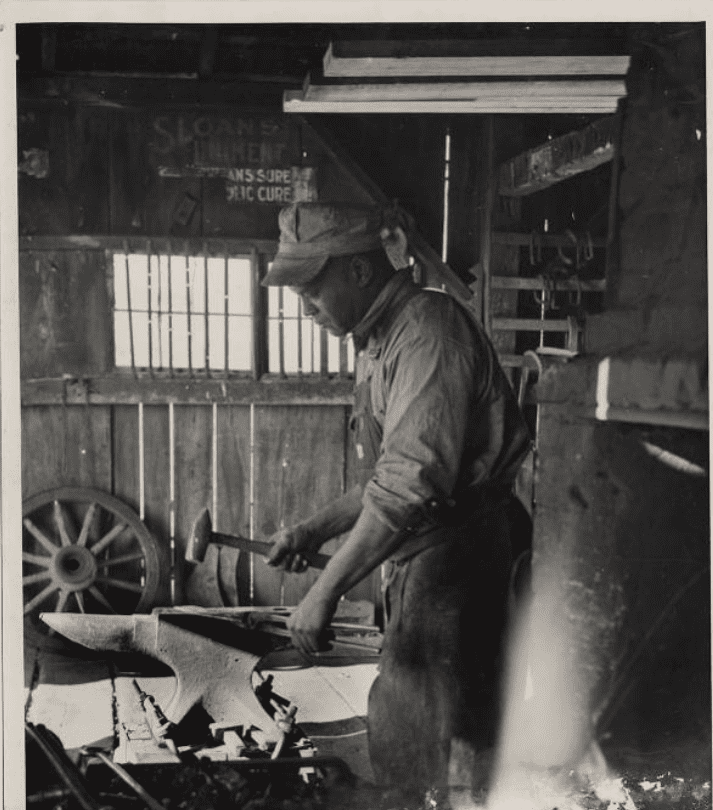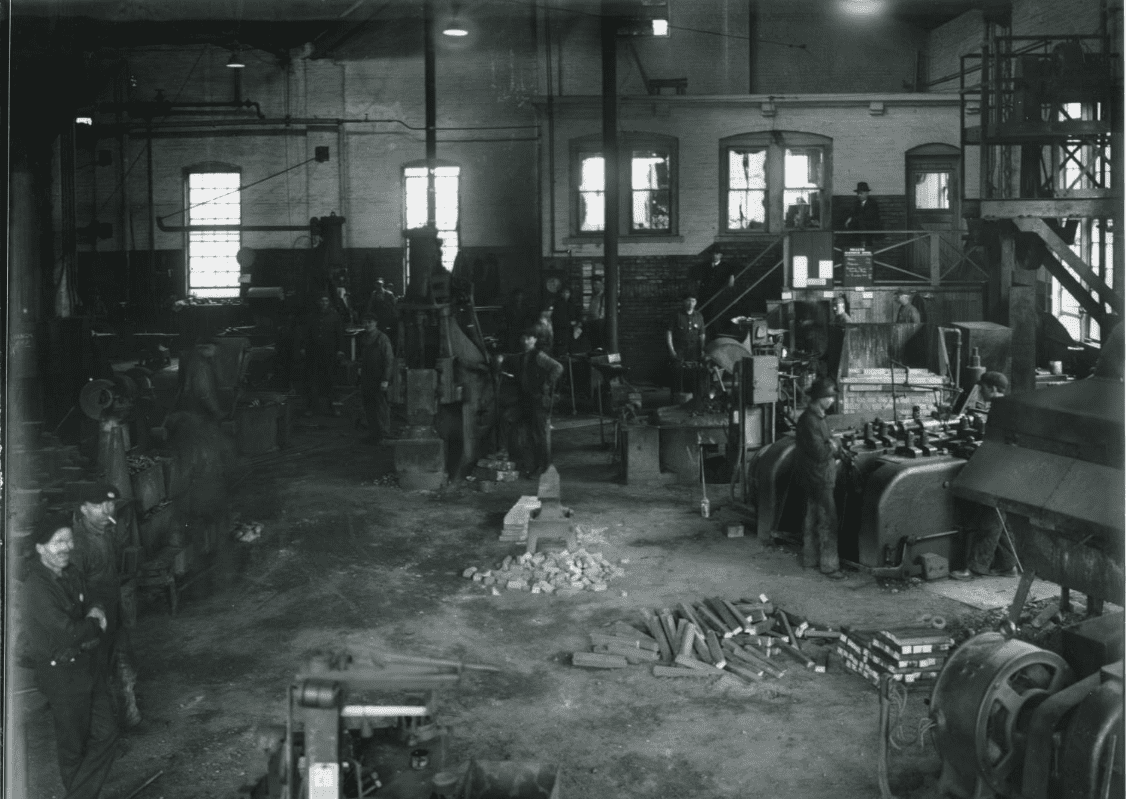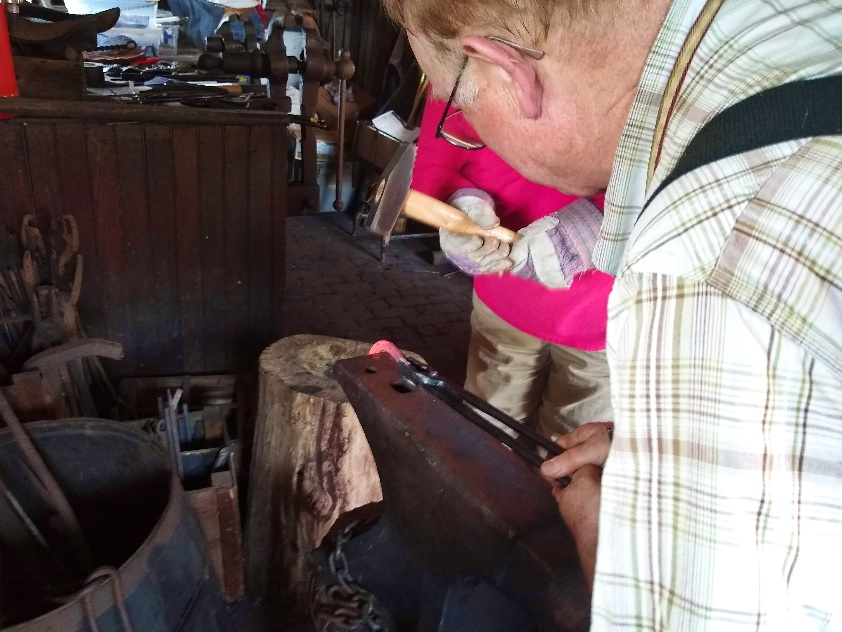Wandering the Stacks and What We Found There
Part 1 of a series that delves into interesting texts found in the Ohio History Connection's Archives & Library
Blacksmithing has been seen throughout history as both a skilled craft and an art form. G.H. Birch, a scholar with the British Architectural Association, summed it up by saying, “The anvil and the hammer were ever at work, and the glow of the forge with its stream of upwards sparks seemed to impart, Prometheus-like, life and energy in to the inert mass of metal submitted to its fierce heat.” This art form has a rich past, connecting the elements from day-to-day life to tales of epic proportions.
Some of the first known examples of blacksmithing come from as early as 3000 B.C.E. Artisans in Egypt, China, Greenland and elsewhere created some of the first iron tools from meteor fragments. Crafting items from metal that fell from the sky contributed to early concepts that blacksmithing was passed down by higher beings. Many ancient cultures linked blacksmithing with mythical elements though many of the supernatural beliefs around blacksmithing began to fade after greater technological development at the dawn of the Iron Age (roughly 500 B.C.E.).

A Cortsville, Ohio blacksmith forges a piece of steel or iron with a hammer and a pair of pliers on an anvil. Via Ohio Memory.
Respect for the blacksmiths’ skill hit a high point by the 10th century C.E., during which the archetype of the “village smithy” developed in Europe. Blacksmiths were prized for their highly technical understanding of steel and were employed in the creation of all manner of goods, from solid farming implements to the weapons and armor used in war. As Europeans expanded across the Atlantic, the importance of blacksmiths came with them. Having a local forge proved crucial in providing many of the building supplies for early settlers and trade goods for local native peoples.
By the mid-19th century blacksmithing as a profession met its first real challenge through the Industrial Revolution. Innovations like the Bessemer Process, a technique developed in 1856 to mass produce high-quality steel, revolutionized the ability for factories to produce large numbers of goods in a short period of time. Rapid modernization of firearms, industrial tools and mass transit relied on precise machining of interchangeable parts, which was yet another process easier for factories than for individual blacksmiths.
 Workers in a blacksmith shop supply parts to a steel mill. Photo via Youngstown Historical Center of Industry and Labor on Ohio Memory.
Workers in a blacksmith shop supply parts to a steel mill. Photo via Youngstown Historical Center of Industry and Labor on Ohio Memory.
By the end of the 19th century, most blacksmiths found themselves out of their typical line of work, and needed to diversify to get by. Shoeing horses became a major source of income for displaced blacksmiths, but the development of the automobile industry quickly reduced the need for this work in the early 20th century.
After a drastic decline in the craft in the 1930s, blacksmithing returned to prominence in the 1970s as an artisanal skill. The American heritage movement, prompted by the bicentennial in 1976, saw many skilled people trying their hand at crafts that their ancestors did during the founding of the nation. Today there are over 10,000 blacksmiths keeping the tradition alive in the United States alone, with roughly 10% of those working professionally.
At Ohio History Connection, we do our part to keep the storied traditions of blacksmithing alive. Specially hosted programs, such as the Aroha Philanthropies-sponsored blacksmith workshop series we offered in 2019, give us the chance to share the rich history of the art while supporting the creative community in Ohio. We also offer classes throughout the year to those who are willing to strike while the iron is hot! Check back with our classes and workshops page to see when new classes might be available.

More than ever we appreciate your support of this vital work in our community. If you can, please consider donating so that we can continue to provide state of the art resources to you and all Ohioans. You can do that at ohiohistory.org/give
Do you have a story to share? Right now, our team is documenting how Ohioans are experiencing today’s historic pandemic. As Ohio’s public history organization, the stories you share with us will help us understand the day-to-day impacts of COVID-19.
If you have images, videos, objects or a personal story to share, click here to learn how you can contribute.